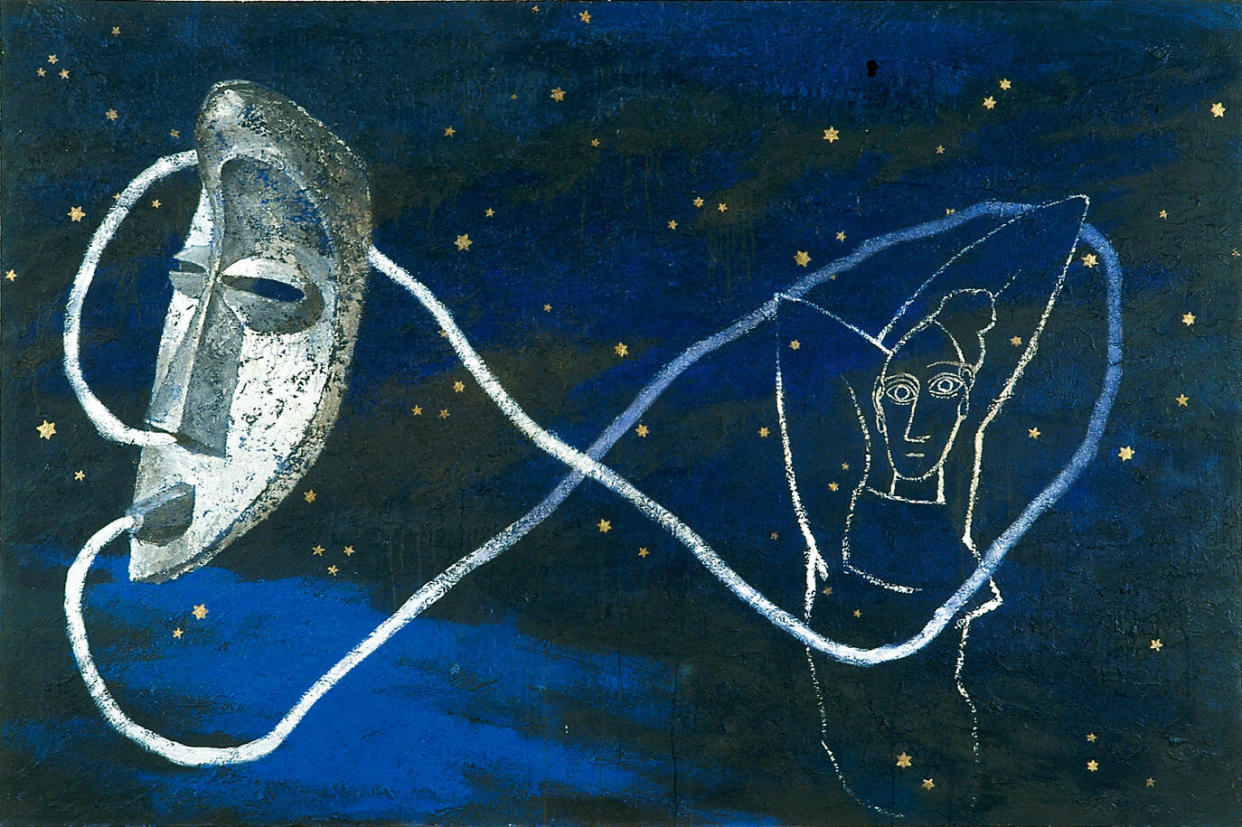Gavin Jantjes: To Be Free! A Retrospective 1970-2023 review – fierce and subtle

Gavin Jantjes – pronounced Yanchez – is not a name on many people’s lips, although he should be. Born in Cape Town in 1948, the year the apartheid regime first devastated South Africa, he is one of the country’s most significant artists. But a lifetime’s exile, moving between Germany, Norway and England, and shifting between several different roles as art historian, writer, educator and curator, have perhaps obscured his singular qualities as an artist. The Whitechapel’s huge survey aims to change that.
It opens with a fierce yet subtle painting, in which two historic works of art float in a limbo of glorious midnight blue space. One is an African mask, the other the central figure from Picasso’s Les Demoiselles D’Avignon, based on just such a mask. They are linked by a ghostly white line, somewhere between umbilical cord and breath, as if one were keeping the other alive. Both sets of eyes are upon us; but those of the Fang mask, ever so slightly angled, have an ironic tilt.
Delicate yet mordant: that is Jantjes’s way. A group of early screenprints, made in the 1970s, has the collective title A South African Colouring Book. Each page plays upon that most contentious word – colour: here are images of black South African miners, of massacred students, of Whites Only signs and exploited workers, alongside extracts of far-right speeches by B J Vorster, South African prime minister until 1978 and ferocious defender of apartheid.
There are paintings that develop into three dimensions, sculptures that punctuate paintings
Jantjes’s own identity card is included, classifying him as a “Cape Coloured”, as if he were no more than an animal or object. And each image has a little strip of colours running along it, from which, it is implied, some innocent child might choose for an afternoon’s fun with the crayons. Colour These Workers, Colour This Labour Dirt Cheap, Colour These People Dead run the instructions. And beneath two photographs of black people at public gatherings, reversed white in negative, the laconic exhortation to do the same thing and Colour These Blacks White.
City Late, from 1976, is a montage of period newspaper clippings positioning reports of the devastating massacres in Sharpeville and Soweto alongside the latest racist statements from P W Botha, Vorster’s successor. A faint ballpoint pen mark appears against the news that a white supremacist has been rescued from certain death by four black men (were they ever thanked?). Handwritten quotations from Frantz Fanon and Amílcar Lopes Cabral, founder of the African Party for the Independence of Guinea and Cape Verde, are incorporated in these images like script in a scrapbook.
Jantjes used paperclips, glue and string in these assemblies of image and word, so that two dimensions sometimes shift into three. It seems to reflect his way of thinking, which is always fluid and associative. The uprising of one African nation immediately links to another, from South Africa to Mozambique, Ghana and Algeria, turning newsprint and photo-reportage into a political adaptation of pop art in a kind of non-stop screenprint sequence.
A South African Colouring Book was banned in 1978, but Jantjes was already in European exile. There he began to reprise collage through the richness of paint. Before Maputo, from 1982, is a stunning assembly of motifs: Tarzan, Henry VIII, a chained ape, a black missionary on his British bicycle, all hovering around the figure of a white teacher as if issuing directly from his head. Afrikaans – famously described by Desmond Tutu as “the language of the oppressor” – was being imposed on black school kids. Yet everything is spectral and pale, as if the man was haunted by the system.
Some paintings are like riddles or pictograms. A hard rain of wooden stakes drives down to a dark earth (itself made of sand, and darkest pigment). A black figure, broken chains trailing behind him, carries the burden of a glowing television on his back. Coffins are borne across the sea by sail, a pictorial elegy that seems to touch on slavery as well as colonial voyages and exile.
It is not always easy – nor should it be – to unpick Jantjes’s allegory. A great plain of white crosses recedes beneath torrential dark skies. The surface of the painting is thickly worked, the earth churning with mud. It takes a moment before you notice that the crosses are made of flocked cotton, and the ground is nubbed all over with chips of dark brown sugar. A guitar floats mysteriously above.
But very often the internal force of the image holds its own irreducible poetry: as with the ring of hard stones, rhyming with the wagons in the barren landscape beneath a rock-hard sky in 1987’s Vaal. Two different cultures are in the same place, for however long – the one that will remain here, dead or alive, and the one that will move on.
Jantjes is extraordinarily various, his idiom shifting all the time. There are paintings that develop into three dimensions, sculptures that punctuate paintings, and considerable shifts from post-pop art to late-flowering expressionism. After a long pause, where he worked in other fields, Jantjes recently established a new painting studio in Oxfordshire.
His latest works are vast and serene: diaphanous abstractions in swirling colours that have no behind or before, and yet somehow convey a sense of both space and depth. They fill the upper floor of the Whitechapel survey, the best of them emitting an uplifting light. And for him, at least, they must carry the very thing he most desires, and has stood for, and written about all through his life – the essential spirit of freedom.
Gavin Jantjes: To Be Free! A Retrospective 1970-2023 is at the Whitechapel Gallery until 1 September

 Yahoo News
Yahoo News 
